 W
WAugmented reality (AR) is an interactive experience of a real-world environment where the objects that reside in the real world are enhanced by computer-generated perceptual information, sometimes across multiple sensory modalities, including visual, auditory, haptic, somatosensory and olfactory. AR can be defined as a system that fulfills three basic features: a combination of real and virtual worlds, real-time interaction, and accurate 3D registration of virtual and real objects. The overlaid sensory information can be constructive, or destructive. This experience is seamlessly interwoven with the physical world such that it is perceived as an immersive aspect of the real environment. In this way, augmented reality alters one's ongoing perception of a real-world environment, whereas virtual reality completely replaces the user's real-world environment with a simulated one. Augmented reality is related to two largely synonymous terms: mixed reality and computer-mediated reality.
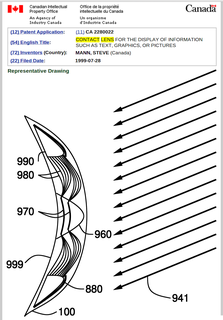 W
WBionic contact lenses are devices that, it is proposed by the manufacturers and developers, could provide a virtual display that could have a variety of uses from assisting the visually impaired to video gaming. The device will have the form of a conventional contact lens with added bionics technology in the form of augmented reality, with functional electronic circuits and infrared lights to create a virtual display allowing the viewer to see a computer-generated display superimposed on the world outside.
 W
WcastAR was a Palo Alto-based technology startup company founded in March 2013 by Jeri Ellsworth and Rick Johnson. Its first product was to be the castAR, a pair of augmented reality and virtual reality glasses. castAR was a founding member of the nonprofit Immersive Technology Alliance.
 W
WA Circular review system is a system on board some armoured combat vehicles or tanks which provides the crew greater situational awareness outside of the vehicle.
 W
WClueKeeper is a GPS location-aware software platform created by a group of puzzle lovers and initially released in 2013. It is an iOS and Android based app for building and playing puzzle hunts. It incorporates features of a puzzle hunt, an escape room, and augmented reality.
 W
WCluetivity is an augmented reality (AR) software platform owned by Life Action Games GmbH. Founded in 2010 by a group of scavenger hunt and tech fans, Cluetivity offer both outdoor and indoor interactive games for iOS devices. The company is currently lead by CEO, Michael Schiemann.
 W
WCuseum is an American startup company that develops products such as mobile applications, digital membership cards, and an augmented reality platform for museums, public attractions, and cultural nonprofits.
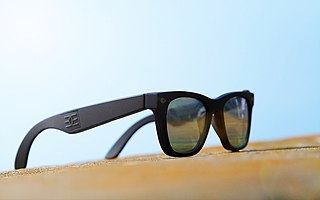 W
WEpiphany Eyewear are smartglasses developed by Vergence Labs. The glasses record video stored within the glasses' hardware for live-stream upload to a computer or social media. The glasses use smartphone technology. The head mounted display is a mobile computer and a high-definition camera. The glasses take photographic images, record or stream video to a smartphone or computer tablet.
 W
WAn EyeTap is a concept for a wearable computing device that is worn in front of the eye that acts as a camera to record the scene available to the eye as well as a display to superimpose computer-generated imagery on the original scene available to the eye. This structure allows the user's eye to operate as both a monitor and a camera as the EyeTap intakes the world around it and augments the image the user sees allowing it to overlay computer-generated data over top of the normal world the user would perceive.
 W
WFar-Play is a software platform developed at the University of Alberta, for creating location-based, scavenger-hunt style games which use the GPS and web-connectivity features of a player's smartphone. According to the development team, "our long-term objective is to develop a general framework that supports the implementation of AARGs that are fun to play and also educational". It utilizes Layar, an augmented reality smartphone application, QR codes located at particular real-world sites, or a phone's web browser, to facilitate games which require players to be in close physical proximity to predefined "nodes". A node, referred to by the developers as a Virtual Point of Interest (vPOI), is a point in space defined by a set of map coordinates; fAR-Play uses the GPS function of a player's smartphone—or, for indoor games, which are not easily tracked by GPS satellites, specially-created QR codes—to confirm that they are adequately near a given node. Once a player is within a node's proximity, Layar's various augmented reality features can be utilized to display a range of extra content overlaid upon the physical play-space or launch another application for extra functionality.
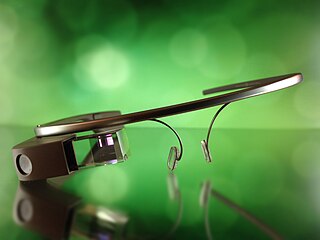 W
WGoogle Glass, or simply Glass, is a brand of smart glasses—an optical head-mounted display designed in the shape of a pair of glasses. It was developed by X with the mission of producing a ubiquitous computer. Google Glass displays information in a smartphone-like, hands-free format. Wearers communicate with the Internet via natural language voice commands.
 W
WGoogle Lens is an image recognition technology developed by Google, designed to bring up relevant information related to objects it identifies using visual analysis based on a neural network. First announced during Google I/O 2017, it was first provided as a standalone app, later being integrated into Android's standard camera app.
 W
WMicrosoft HoloLens 2 is a pair of mixed reality smartglasses developed and manufactured by Microsoft. It is the successor to the pioneering Microsoft HoloLens. On February 24, 2019 the HoloLens 2 enterprise edition debuted as the first variant of the device, followed by a developer edition that was announced on May 2, 2019. It was subsequently released in limited numbers on November 7, 2019.
 W
WIndustrial augmented reality (IAR) is related to the application of augmented reality (AR) to support an industrial process. The use of IAR dates back to the 1990s with the work of Thomas Caudell and David Mizell about the application of AR at Boeing. Since then several applications of this technique over the years have been proposed showing its potential in supporting some industrial processes. Although there have been several advances in technology, IAR is still considered to be at an infant developmental stage.
 W
WInvizimals is an augmented reality video game franchise developed by Novarama and published by Sony Computer Entertainment Europe. The series, which originally began in 2009 as a video game on PSP, has since inspired toys, trading cards, comics and an animated television series telling an interconnected transmedia story.
 W
WLayar was a Dutch company based in Amsterdam, founded in 2009 by Raimo van der Klein, Claire Boonstra and Maarten Lens-FitzGerald. They created a mobile browser app called Layar. The browser allowed users to find various items based upon augmented reality technology.
 W
WLM3LABS is a start-up company that develops hardware and software for motion-based control of computers.
 W
WLumus is an Israeli-based Augmented Reality company headquartered in Ness Ziona, Israel. Founded in 2000, Lumus has developed technology for see-through wearable displays, via its patented Light-guide Optical Element (LOE) platform to market producers of smart glasses and augmented reality eyewear. Lumus' technology enables a small natural looking form factor, wide field of view and true see-through performance.
 W
WLusoVU is a Portuguese startup, founded in 2013 as a spin-off of LusoSpace, a company specialized in satellites components, which operates since 2002. It has prominent clients such as the European Space Agency.
 W
WMagic Bytes LLC is an American software development company and video game publisher. It develops software for immersive experiences in Virtual Reality and Augmented Reality for education, entertainment and training simulation. The company was founded in 2017 by Thomas Meiertoberens, who originally introduced the label Magic Bytes in 1987 for publishing the first video game adaptions of comic characters Clever & Smart, Pink Panther and Tom & Jerry.
 W
WMagic Leap, Inc. is an American startup company that released a head-mounted virtual retinal display, called Magic Leap One, which superimposes 3D computer-generated imagery over real world objects, by "projecting a digital light field into the user's eye", involving technologies potentially suited to applications in augmented reality and computer vision. It is attempting to construct a light-field chip using silicon photonics.
 W
WMeta was a company that designed augmented reality products. The company was founded by Meron Gribetz in 2013. The company furloughed two-thirds of its approximately 100 employees in September 2018. In 2019, the company declared itself insolvent and sold all its assets in a foreclosure sale. In all, investors — BOE Technology Group, Draper Associates, Horizons Ventures, and others — sank $73 million into Meta.
 W
WMicrosoft HoloLens, known under development as Project Baraboo, are a pair of mixed reality smartglasses developed and manufactured by Microsoft. HoloLens was the first head-mounted display running the Windows Mixed Reality platform under the Windows 10 computer operating system. The tracking technology used in HoloLens can trace its lineage to Kinect, an add-on for Microsoft's Xbox game console that was introduced in 2010.
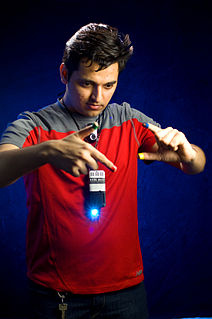 W
WPranav Mistry is a computer scientist and inventor. He is the President and CEO of STAR Labs since October 2019. He is best known for his work on SixthSense, Samsung Galaxy Gear and Project Beyond.
 W
WSuranga Nanayakkara is a Sri Lankan born computer scientist and Inventor. As of 2016, he was the head of Augmented Human Lab and associate professor at Auckland Bioengineering Institute, University of Auckland. Before moving to Auckland, he was an assistant professor at Singapore University of Technology and Design. He is best known for his work on FingerReader/EyeRing and Haptic Chair. His research interests include Wearable Computing, Assistive Technology, Ubiquitous computing, AI, Collective intelligence and Robotics. MIT Technology Review honored Nanayakkara as one of the Innovators Under 35 for Asia Pacific Region 2014.
 W
WNiantic, Inc. is an American software development company based in San Francisco. Niantic is best known for developing the augmented reality mobile games Ingress, Pokémon Go, and Harry Potter: Wizards Unite. The company was formed as Niantic Labs in 2010 as an internal startup within Google. The company became an independent entity in October 2015. It has offices in San Francisco, Bellevue, Los Angeles, Sunnyvale, Hong Kong, Tokyo and London.
 W
WThe OpenIllusionist Project is a computer program for the rapid development of augmented reality applications. OpenIllusionist provides software libraries to make easier the tasks of generating these images, performing the necessary computer vision tasks to interpret the user input, modelling the behaviour of any of the virtual objects, and threading all of the above to provide the illusion of reality.
 W
WProjection mapping, similar to video mapping and spatial augmented reality, is a projection technique used to turn objects, often irregularly shaped, into a display surface for video projection. These objects may be complex industrial landscapes, such as buildings, small indoor objects or theatrical stages. By using specialized software, a two- or three-dimensional object is spatially mapped on the virtual program which mimics the real environment it is to be projected on. The software can interact with a projector to fit any desired image onto the surface of that object. This technique is used by artists and advertisers alike who can add extra dimensions, optical illusions, and notions of movement onto previously static objects. The video is commonly combined with, or triggered by, audio to create an audio-visual narrative. In recent years this technique has also been widely used in the context of cultural heritage as it has proved to be an excellent edutainment tool thanks to the combined use of a digital dramaturgy.
 W
WRecon Instruments was a Canadian technology company that produced smartglasses and wearable displays marketed by the company as "heads-up displays" for sports. Recon's products delivered live activity metrics, GPS maps, and notifications directly to the user's eye. Recon's first heads-up display offering was released commercially in October 2010, roughly a year and a half before Google introduced Google Glass.
 W
WSixthSense is a gesture-based wearable computer system developed at MIT Media Lab by Steve Mann in 1994 and 1997, and 1998, and further developed by Pranav Mistry, in 2009, both of whom developed both hardware and software for both headworn and neckworn versions of it. It comprises a headworn or neck-worn pendant that contains both a data projector and camera. Headworn versions were built at MIT Media Lab in 1997 that combined cameras and illumination systems for interactive photographic art, and also included gesture recognition.
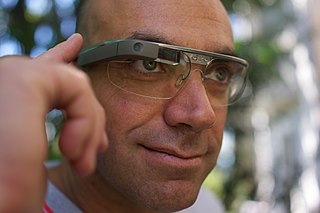 W
WSmartglasses or smart glasses are wearable computer glasses that add information alongside or to what the wearer sees. Alternatively, smartglasses are sometimes defined as wearable computer glasses that are able to change their optical properties at runtime. Smart sunglasses which are programmed to change tint by electronic means are an example of the latter type of smartglasses.
 W
WSpirit Camera: The Cursed Memoir is a spin-off game in the Fatal Frame series, co-developed by Tecmo Koei and Nintendo for the Nintendo 3DS. The game comes with an "AR notebook", the titular Diary of Faces, which the player uses in conjunction with the game. It was released in Japan on January 12, 2012; in North America on April 13, 2012; and in Europe on June 29, 2012.
 W
WA synthetic vision system (SVS) is a computer-mediated reality system for aerial vehicles, that uses 3D to provide pilots with clear and intuitive means of understanding their flying environment.
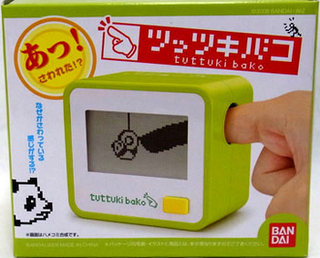 W
WTuttuki Bako (ツッツキバコ) is a roughly cubic hand-held electronic game created by Bandai in 2008. The game comprises five mini-games, and a resettable alarm clock. While the minigames are rather simplistic, Tuttuki Bako has received international acclaim for its unique means of control and the game has been put forward as an archetypal example of Akiba-kei and Japanese gadgetry in general.
 W
WWayRay is a technology company with offices in Switzerland, United States, China, Hong Kong, Germany, and Russia. It develops holographic AR technologies for connected cars. WayRay's in-house R&D center and prototyping facilities create holographic optical systems, complex mechanics, electronics, and software.
 W
WWikitude is a mobile augmented reality (AR) technology provider based in Salzburg, Austria. Founded in 2008, Wikitude initially focused on providing location-based augmented reality experiences through the Wikitude World Browser App. In 2012, the company restructured its proposition by launching the Wikitude SDK, a development framework utilizing image recognition and tracking, and geolocation technologies.
 W
WWindows Mixed Reality is a mixed reality platform introduced as part of the Windows 10 operating system, which provides augmented reality and mixed reality experiences with compatible head-mounted displays.
 W
WWonderbook is an augmented reality peripheral for the PlayStation 3 console. The user holds a physical book-like object and stories come to life as the software displays content on the television's screen.
 W
WZugara is an American corporation headquartered in Los Angeles, California, United States that develops and licenses Augmented Reality software and creates Natural User Interface experiences for brands.